I recently finished Norman Friedman's British Destroyers and Frigates, and while I have no intention of serializing the whole thing here, there were a few particular ships that he discussed which seemed worth looking at in more detail for what they show about warship procurement.
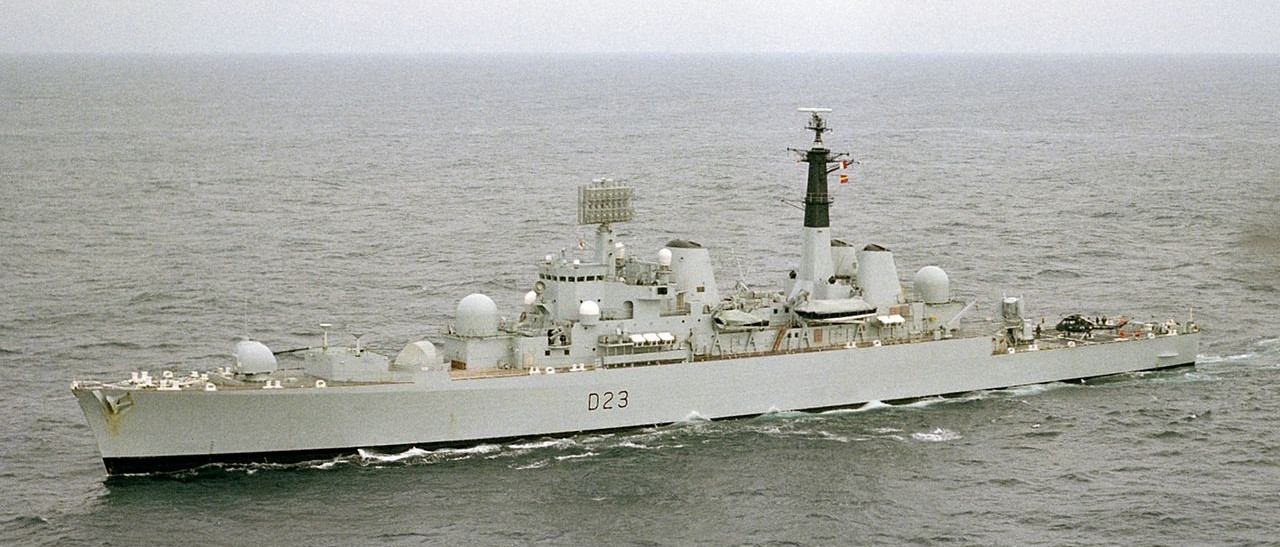
HMS Bristol
Our saga begins in the early 60s, when Britain was looking at building its second generation of postwar missile ships. The main task was to protect the new carriers that were also being designed, which in turn would need new weapons. The Sea Slug used by the County class, the first British missile ships, was a rather clumsy system, and it was to be replaced by the Sea Dart. Anti-submarine firepower would be provided by the Australian Ikara system, a remote-controlled rocket glider that could reach out to 20,000 yards or so, the maximum range achievable by sonars of the day. Both systems were necessary because the British expected to face down Soviet proxies armed with the latest in Eastern Bloc weapons, including nuclear submarines.
Studies were run to determine the number of ships needed for both roles given the planned deployment of a two-carrier group. Ultimately, they showed that the best option was to place both weapons on a single ship, which would be cheaper than dedicating a vessel to each role, particularly due to economies in required crew. Unfortunately, the resulting ship would also be quite large and expensive, at least three times the cost and displacement of the preceding Leander class frigate, which the new ship had originally been pitched as a replacement for. Civilians on the Admiralty staff saw a problem with this. Politicians and the public are far more sensitive to certain types of costs than others, and costs that tend to attract particular notice include the headline cost of a single ship, while the total cost of a fleet is far less visible.
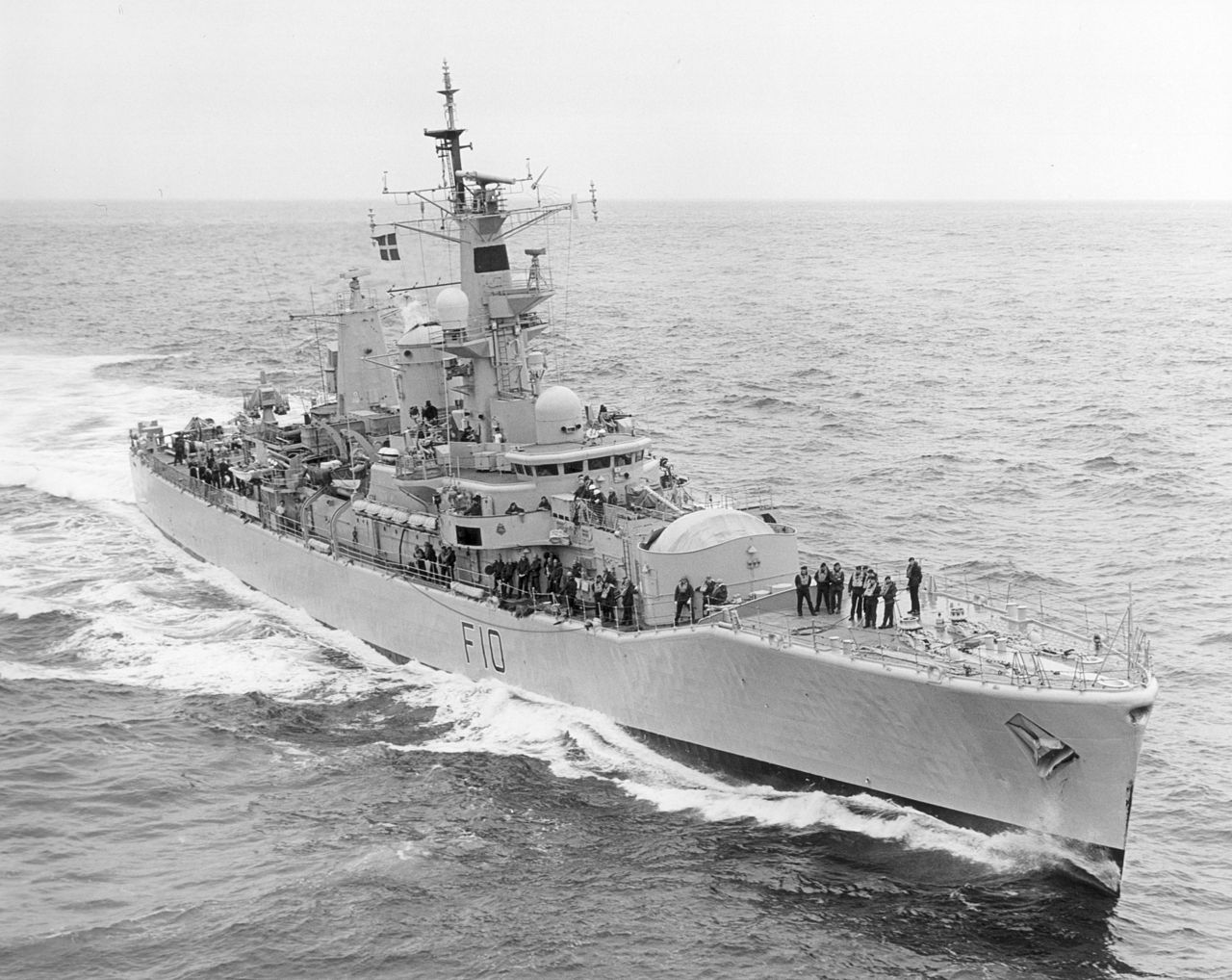
HMS Aurora, a Leander converted to carry Ikara (in the domed structure forward)
This problem, combined with the cancellation of the new carrier in 1966, ultimately limited the design in question, known as the Type 82, to a single ship, HMS Bristol, and she was primarily built to get the systems to sea more quickly. The Ikaras would go to sea on converted Leanders, but that wasn't really an option for Sea Dart, and a new design was started. This design, designated Type 42, was in many ways a reaction to the excesses of the Type 82, and from the start of the design process, tight controls were kept on cost. Many features that had been standard, such as provisions for underway replenishment, washdown systems, separate galleys for officers and enlisted and multiple anchors were deleted. The ships were also designed with no provisions for satellite communications, ESM systems or any sort of close-in anti-missile system, although some of these cuts were reversed later in the process. To keep excess stuff from being crammed in, length was limited to 392', which forced the gun (fitted to give the ship some capability in limited-war roles) and missile launcher to be very close to the bow. The ships were very wet forward, and these systems were vulnerable to damage from heavy seas. None of these were particularly good decisions, but they were all dwarfed in badness by the initial decision to leave out a second illuminator for the missile system, which essentially halved missile firepower to save £750,000 on an £11 million design. Fortunately, this was too much stupidity to actually go through, and the ships were completed with two illuminators.1
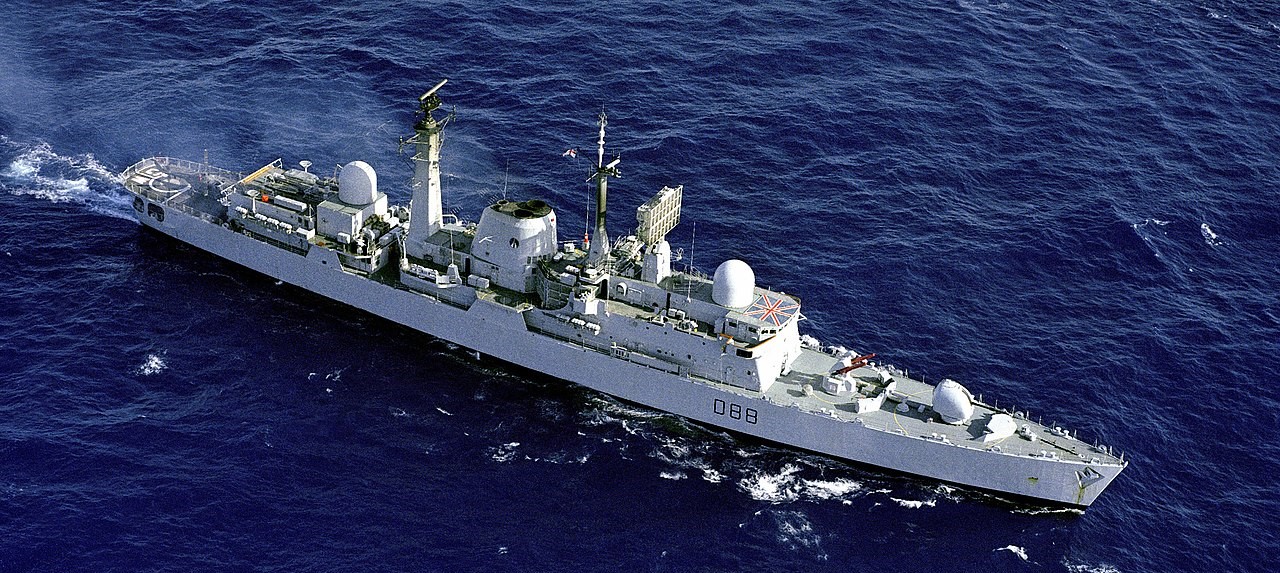
HMS Glasgow, an early Type 42
But even though the result was less austere than some of the proposals, it was still not up to the traditional standards of British warships, and it soon became apparent that the cuts had gone too far. Structural problems surfaced on the first ships, and they had to be given external stiffening. Some improvements were made starting with the seventh ship, Exeter, including fixing the structural issues, but the big change would come with the so-called Batch 3 ships, the last four of the 14 built. These were stretched to 434'2 to give more room for all of the equipment that goes into making a modern warship, most notably a larger missile magazine. Unfortunately, the analysis for the longer hull used a new method that was very difficult to implement, and a mistake meant that the hulls were again too weak, and the Batch 3 ships required visible reinforcing strakes.3
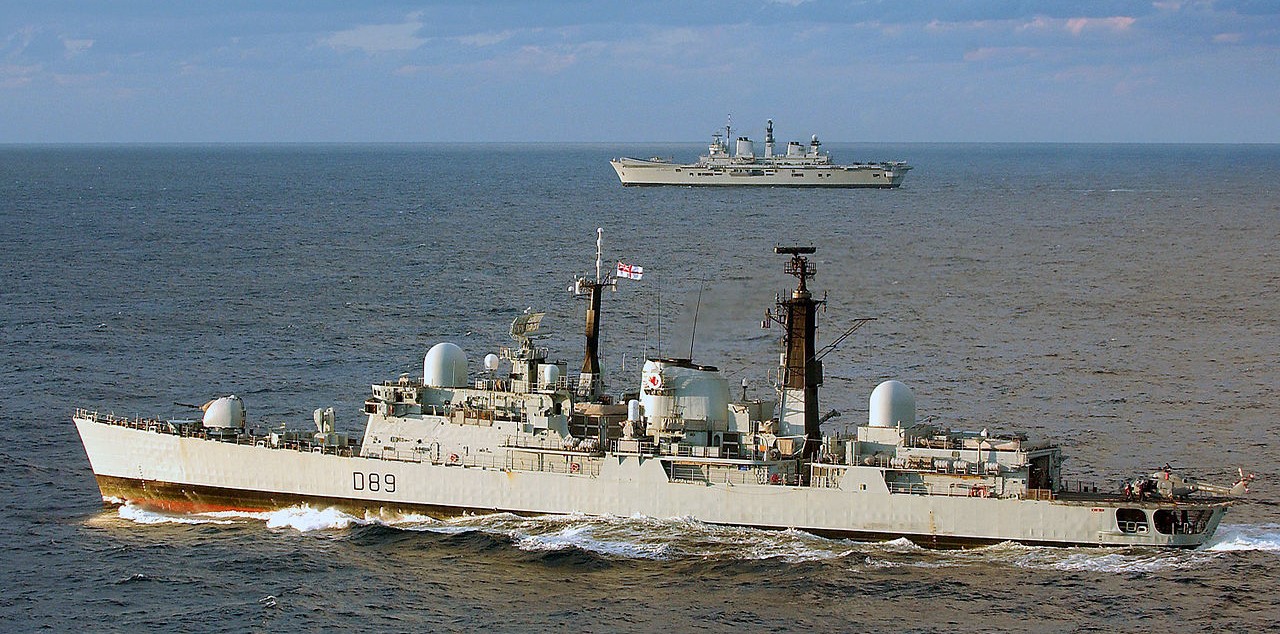
HMS Exeter operates with HMS Illustrious
The cuts made to the Type 42 design would come back to haunt the British when ships of that class formed the backbone of the air-defense force in the Falklands. Three vessels, Glasgow, Sheffield and Coventry, all took damage from air attack, with the later two ships being lost in no small part due to the cost-cutting in the basic design. A major contributor to Sheffield's loss was, weirdly, her short length. This had left her rather cramped, and when the SCOT satellite communications system was fitted, it had to go in a place where its signal would blank out the ESM system. She happened to be communicating when the Super Etendards attacked, which left her blind to their approach, and the lack of any jammer or close-in weapons beyond a few hand-worked Oerlikons meant that she couldn't do anything about their Exocets. The problems caused by cost-cutting continued after the missile hit, too. Power was lost because there were no emergency generators outside the engineering spaces, which were flooded because of the use of a gravity-feed header tank, which cracked under the attack. The casings for the gas turbines also cracked, filling the machinery spaces with a horrible whine. A bigger problem was the lack of smoke barriers, which forced the crew to evacuate, even though Sheffield stayed afloat for six days after the attack.
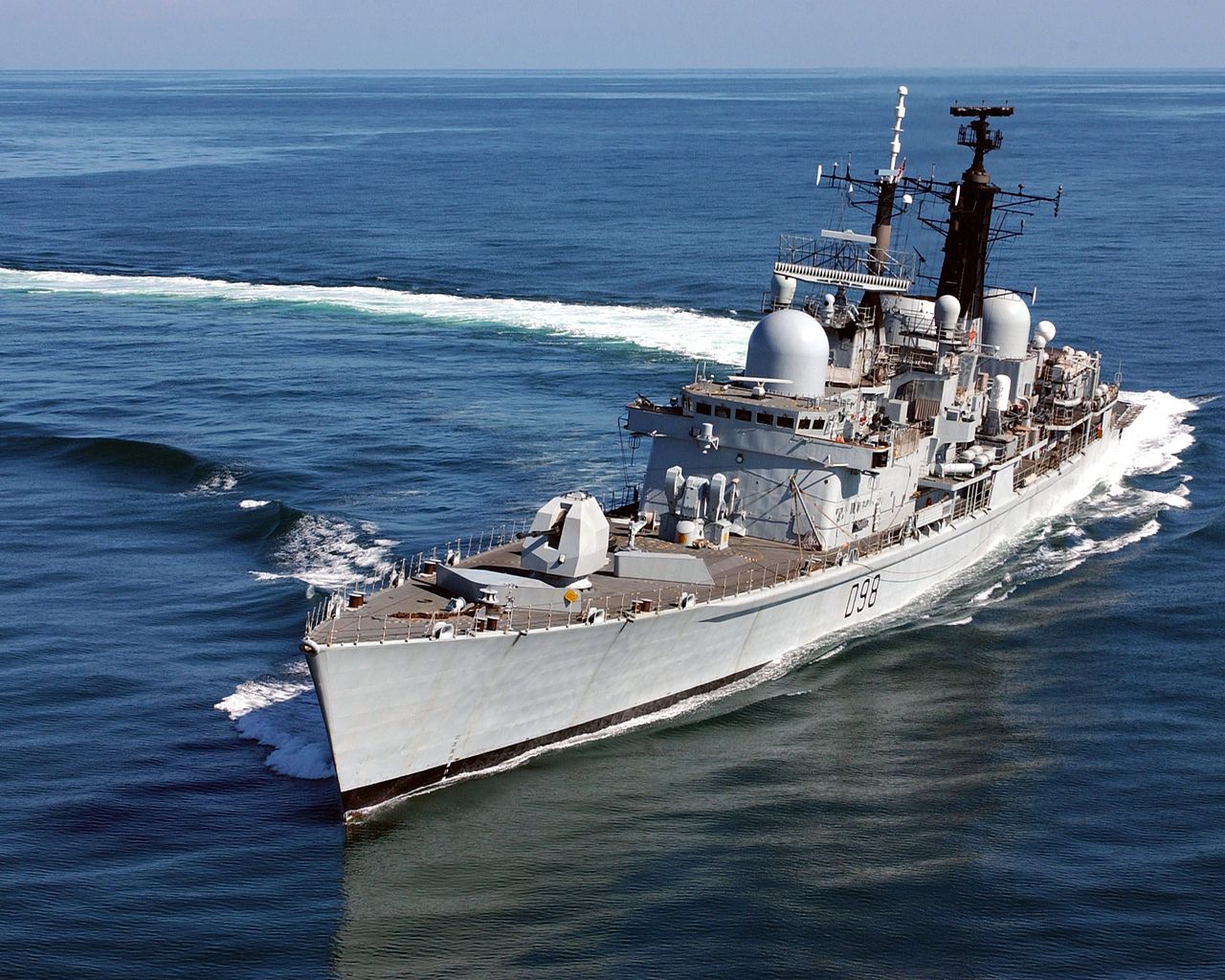
HMS York, a Batch 3 Type 42, showing her reinforcing strakes (just below the edge of the deck)
Coventry's loss was at least partially the result of similar factors. She was late in picking up the approaching Skyhawks as they crossed West Falkland because fiscal constraints had preventing the British from fitting moving target indication (MTI) radar, which would have had much better performance overland. A secondary cause was the lack of any point-defense system, such as Sea Wolf, which had been slated for installation at one point, but which didn't fit on the very tight design. Glasgow also was affected by this problem, and the weapon issues that she faced when under attack were likely at least in part due to how far forward her gun and Sea Dart were. She was also suffering from engineering issues even before the attack, another indication of a tight design.
But Type 42 was far from the only British warship of this era affected by this kind of problem, and we'll take a look at her contemporary, the Type 21, next time.
1 DK Brown actually uses the second illuminator as an example of scope-creep, arguing that it wouldn't help in the low-threat areas the Type 42 was designed for. I don't agree, on the grounds that there are a lot of cases where you want to be able to shoot at two targets at once, certainly enough that your main fleet air-defense ship should be able to do so. ⇑
2 Some sources (including the Wiki article) state that the class was originally designed at 434' and then cut down to 392'. Friedman says this is not true, which accords with how warships are generally designed. ⇑
3 One of the oddest proposals for the Type 42 came in the early 70s, when the oil crisis drove up fuel costs. Converting the ships to burn coal somehow was investigated, but it was concluded that it was easier to turn the coal into oil ashore. ⇑

Comments
Looking forward to more of this. The split between type 42s and 22s, rather than opting for fewer multipurpose destroyers seems like a bad call to me, but it does let you spread your combat systems over more ships, and if it's ship numbers the public/politicians care about...
It seems like choices then lead to the current split between type 45s and the type 23/26, so the shape of today's navy is heavily shaped by choices made over half a century ago.
The Type 42 is contemporary with the Type 21, not the Type 22, so there was never that much chance of them being merged. The Type 82 was the attempted multipurpose destroyer, and it was too big and too expensive. It's worth pointing out that the USN is almost unique in not having an AAW/ASW split in its ships, and that's a relatively recent development, driven by gold-plating requirements and the inability to design working warships that aren't Burke variants. The high-low split in the 70s and 80s was Tico/Perry.
I'm getting my ships confused then. I had an image of the type 21 as some sort of cheap general purpose frigate, equivalent to the modern type 31 rather than an ASW specialist. Clearly I need to read the next in the series Ü
Actually, you're correct on that. The big issue was that the budget was crunched, and they wanted some ships to bridge the gap between the Leanders and the later ASW-focused ship that became the Type 22. (There's also the use of a commercial design for reasons I'll go into next time.)
The Sea wolf system was never considered for the T42 destroyers, it was thought at the time( 1968)the Sea Dart would provide all the missile defence needed. There was a smaller Type 43 derivative design considered with Sea Dart, Exocet up front and Sea Wolf at rear -but no main gun or helicopter hangar but a landing spot
😊
The proposed T43 the smaller follow in to T42 , had the exocet and sea wolf but no helicopter hangar. This was the only T42 version to be designed for Sea wolf
Everything in this post came straight out of Friedman's British Destroyers & Frigates. So unless I catastrophically misread something (I'd like to think this is unlikely) or Friedman is wrong (not completely impossible, but rare) there was at some point in the design process a plan for Sea Wolf. It's entirely plausible it was quite early, because I wrote this a couple years ago and remember basically no details.
D.K. Brown's point was that Type 42 (and succeeding projects) did not anyway have the ammunition capacity to make best use of having two and more illuminators and launchers. It was the 80s-era equivalent of the modern problem of today's warships being able to track hundreds of targets and spit out half a dozen missiles a minute, but deployed regularly with only enough missiles for five or so minutes of fire. Granted, he may be nitpicking a little, but then again, even the US Navy did not manage to deploy significant numbers of AEGIS-equipped Ticonderogas to deal with Soviet missile saturation attacks before the whole thing was rendered moot by the fall of the Berlin Wall. How well would, say, a pair of Virginia NTUs actually perform against fifty or so Backfires?
That is not what I get from Rebuilding the Royal Navy (p.91). His criticism is a bit less forceful than I remembered, but he definitely does not seem to view doubling ability to handle targets at a fairly small cost to be a clear good, which I find very weird.
I've done a lot of work with NTU California in CMO, which could about handle 16 missiles when I tested it against Backfires.
Which is why I suspect DKB was nitpicking. The T42s originated as the cheaper "little brother" of the T82 fleet escort. In that light then, it's akin to wondering why Perry-class frigates carry Mk13s and not Mk26s. The flaw in DKB's commentary is that after T82 was binned, T42 became the air warfare fleet defender which makes the upgrade sensible, albeit retrospectively and by chance. (Which is as unforeseeable as expecting the Perrys to be equipped with Mk26 and good radar on the off-chance that Ticonderoga fails.) Probably, he was thinking that T42 ought to stay within its remit and funds should instead go towards a proper full-size air warfare destroyer, i.e. getting T43-44 on the go right away, using the AEGIS system. At least, that's how I interpret the chapter. Right, 16 missiles. Check out "Kamikazes: The Soviet Legacy", it's a short paper on (supposed) Soviet naval aviation tactics by Maksim Tokarev, I'd be keen to know what you think.
That's not what I got from that section, where he pretty explicitly opines on that as mission creep in a way that doesn't make a lot of sense for a ship that ended up as the primary AD platform for the RN for a few decades, even if it had some fairly serious problems in that role.
Hmm. That does sound interesting. Thank you.
I did not. Got distracted, although it is still vaguely on my to-do list.